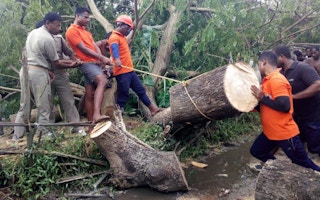A tropical cyclone has formed in the Bay of Bengal over the weekend and is due to hit the Indian state of Odisha. If the past is any guide, Cyclone Sitrang may bring flooding, destroyed crops, collapsed buildings and loss of life.
For a disaster to happen, hazard and vulnerability must come together. Human-caused climate change is affecting hazards now, such as decreasing the frequency of tropical cyclones while increasing their intensity. A tropical cyclone, though, does not need to harm health if people and infrastructure are ready for it and can cope with it.
The vulnerability – or how society deals or cannot deal with hazards – is what creates the disaster. Vulnerability is a societal process setting up people and places to be harmed by potential hazards. Examples are poorly constructed buildings, breaking planning regulations, not having insurance, not receiving or understanding warning messages due to language differences, being unable to evacuate due to illness or mobility difficulties, fearing assault in an emergency shelter, and many others.
The disaster is not that Hurricane Ian swept over Cuba and Florida in September. The problem is that Cuba’s electricity grid failed in a storm less powerful than previous ones and that Florida has had rampant coastal development without accounting for flooding.
So, the phrase ‘natural disaster’ is a misnomer. Disasters come from vulnerability, not from hazards originating in nature.
By definition, human-caused climate change affects the weather, but by definition, weather does not cause disasters. Therefore, by definition, climate change does not cause disasters.
There are lethal exceptions, one impacting us terribly now: human-caused climate change is pushing heat-humidity into realms that are beyond human survival. In British Columbia in 2021 and England and Wales in 2022, deaths from heat waves were directly attributable to human-caused climate change.
Many workers cannot escape the devastating heat-humidity. Agricultural labour is especially affected, impacting the world’s food supplies. Wildfire smoke exacerbated by climate change is worsening respiratory ailments. And, in an example of vulnerability, many cannot afford artificial indoor cooling which, in any case, can lead to blackouts through overuse.
Other physical health impacts from climate change could emerge in the future. Coastal food systems could be undermined by acidifying oceans in coming years. Over centuries, sea-level rise could require megacities and low-lying island communities to relocate. Without advance planning and support, health impacts could be severe.
Meanwhile, science is only just beginning to understand the effects of climate change on mental health. So far, no unambiguous correlation of self-harm with human-caused climate change has been identified. Yet data quality is poor, since self-harm including suicide is stigmatised and not always recorded comprehensively. As well, prevention and treatment can avert self-harm, irrespective of environmental changes.
Heat-humidity nonetheless influences interactions between mental and physical health. Heat-humidity physically stresses our bodies which can compound into mental stress. Schizophrenia, depression, dementia, and others seem to be directly affected by heat-humidity. Some medications for mental health and wellbeing conditions impede the body’s ability to adjust to heat-humidity while the effectiveness of others changes with temperature.
Doom-laden narratives of climate change now have a demonstrable and detrimental effect on mental health and wellbeing. Eco-anxiety and climate grief through the ‘climate crisis’ story manufacture doomerism and reduce nuances, such as incorrectly attributing many disasters to climate change. Reporting and action should balance eco-grief and eco-inspiration.
Hope emerges from activities to avoid the worst of human-caused climate change, such as reducing excess consumption, while adjusting to observed and ongoing impacts.
Cyclone deaths have declined in Bangladesh while the most lethal US hurricane to make landfall so far was long ago, in 1900. Mental health conditions can be de-stigmatised to support affected people. All these required decades to achieve and evidence, so further actions must start now.
Health systems worldwide are currently not resourced or robust enough to meet current and future health needs. They are in crisis, burning out healthcare professionals and failing to serve people’s health needs, with austerity killing patients irrespective of climate change. We cannot develop and implement effective health policy and practice by suddenly blaming long-standing, deep-seated, fundamental problems on a single topic, such as human-caused climate change.
Yet heat-humidity is significantly adding to these problems now, detailed in Lancet Countdown’s forthcoming 2022 report, even as some trends documented in the report offer hopeful direction. Public and political engagement in health and climate change appears to be increasing, with climate action change increasingly focusing on health.
Most notably, the Covid-19 response shows that countries are willing to invest public money for tackling an immediate health danger. This dedication must be transferred to climate change, especially for strengthening health systems. Prioritising our health contributes to redressing all global difficulties, including climate change.
Ilan Kelman (ORCID) is Professor of Disasters and Health at University College London, England, and a Professor II at the University of Agder, Kristiansand, Norway.
Originally published under Creative Commons by 360info™.
To continue reading, subscribe to Eco‑Business.
There's something for everyone. We offer a range of subscription plans.
- Access our stories and receive our Insights Weekly newsletter with the free EB Member plan.
- Unlock unlimited access to our content and archive with EB Circle.
- Publish your content with EB Premium.










